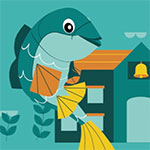How to Ice Fish
If you like spending time outdoors in the northern states during the winter months, then ice fishing is a great experience and fishing option.
Learning how to ice fish provides anglers with a unique experience to fish almost any spot of a lake or river without a boat in frozen environments. It can also offer individuals a chance to get outside, breathe in the winter air and enjoy time with family and friends.
Of course, a unique activity like learning how to fish on ice requires a few unique tools as well. Luckily, unique does not necessarily mean expensive. In fact, beginner ice fishing gear can be quite budget-friendly, even when it comes to that most important item of ice fishing equipment: the ice auger. This ice fishing tool is used to drill holes into the ice on a frozen lake, pond or river and is available in a variety of modes, from manual, to gas-powered, to now, electric-powered augers capable of drilling several dozen holes on a single charge.
Ice fishing rod/reel combos vary depending on the types of fish targeted. However, when learning how to ice fish, you will see what distinguishes them from other rod/reel combos is that their respective lines are not meant to be cast, but rather, dropped down through the hole cut with the auger.
Believe it or not, maggots are often listed near the top of the list when it comes to choosing the best ice fishing bait. Other popular forms of bait include leeches, wax worms, and minnows. Use in combination with jigs – hands down the most popular lure used, and not only by those learning how to ice fish – to attract everything from perch to walleye.
Other ice fishing tips for those learning how to ice fish includes using a common kitchen sieve to keep the ice from reforming over your hole. Don’t forget to protect yourself from the elements to the best of your ability. For example, to help provide protection from the wind and cold, some anglers often fish inside of ice shanties or portable shelters. In addition to proper, warm clothing, wear boots with cleats to make walking easier. Bring a small snow shovel in case you need to clear a layer of snow. If in an area susceptible to blizzards, be sure to have a GPS on hand to help you navigate back to safety.
Learning how to ice fish today can be far easier – and more comfortable – than you may have previously imagined. Give it a try!
For more advanced information, click on the links to learn more about ice fishing gear and ice fishing techniques.
KEEP LEARNING

First Catch Center Trailer Gallery
FCC Trailer Photo Gallery
LEARN MORE

How to Tie a Duncan Knot
Learn to tie a Duncan knot by following these five simple steps. Watch our new video.
LEARN MORE

Welcome to Angler Academy!
No one said you can’t bring fishing inside! There’s lots of fun activities we can do right from home
LEARN MORE


.png?lang=en-US&ext=.png)